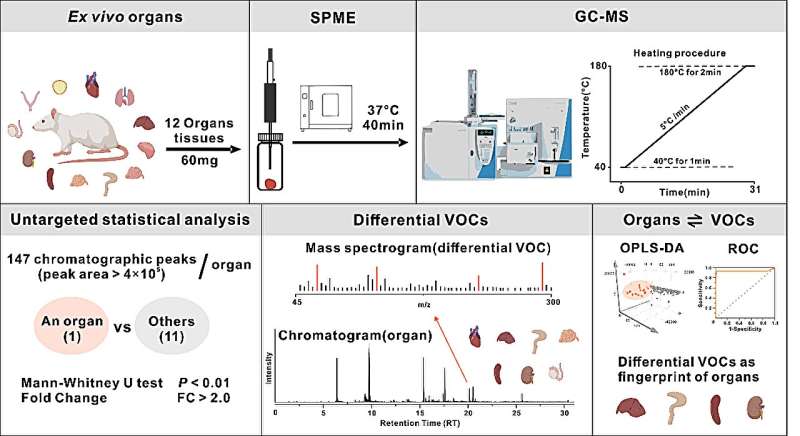This article has been reviewed according to Science X's editorial process and policies. Editors have highlighted the following attributes while ensuring the content's credibility:
fact-checked
trusted source
proofread
Advanced GC-MS detection enables metabolomics analysis in model animals

A research team led by Prof. Chu Yannan at the Hefei Institutes of Physical Science of the Chinese Academy of Sciences applied the untargeted analytical method of headspace solid-phase microextraction-gas chromatography-mass spectrometry (HS-SPME-GC-MS) to detect volatile organic compounds (VOCs) in rat organs and obtained the biological information of VOCs metabolized by related organs.
The results were published in Analytical Chemistry and the article was featured on the cover page.
The detection of VOCs in human metabolites has the potential to change the way we screen for and diagnose organ disease. It is expected to become a non-invasive method for identifying and monitoring disease in the body. However, whether VOCs are present in normal organs and whether there are differences in VOCs among different organs are still pressing issues to be explored.
In this study, the researchers analyzed and detected organs in a controlled laboratory setting using rats, which have a high genetic similarity to humans. Using HP-SPME-GC-MS technology, VOCs released from 12 organ tissues were measured, and chromatographic peaks were obtained. Based on the Mann Whitney U test and fold change, untargeted analysis revealed that seven organs showed differences in VOCs compared with other organs.
This study represents the first systematic report on the differential VOCs found in different organs of rats. The researchers extensively discussed the potential metabolic pathways of these VOCs and their possible role as biomarkers of disease.

The results provide valuable insights for understanding organ-specific VOC profiles and their potential implications for disease diagnosis and monitoring.
In addition, by combining orthogonal partial least squares discriminant analysis (OPLS-DA) with receiver operating characteristic curve (ROC), the researchers were able to validate the discriminative power of the differential VOCs in detecting each organ.
This approach provides a reliable and accurate method for organ recognition based on VOC profiling, and the VOCs profiles of healthy organ tissues obtained in this study can serve as a baseline for scientific research, such as non-invasive screening and diagnosis of gas biopsy or breath test, disease treatment monitoring, and efficacy evaluation.
More information: Yue Liu et al, HS–SPME–GC–MS Untargeted Analysis of Normal Rat Organs Ex Vivo: Differential VOC Discrimination and Fingerprint VOC Identification, Analytical Chemistry (2023). DOI: 10.1021/acs.analchem.3c01546
Provided by Chinese Academy of Sciences





















